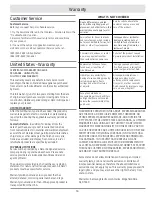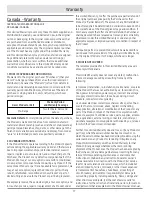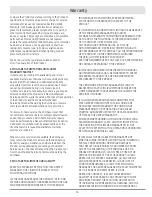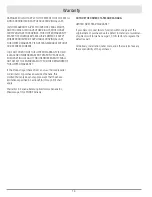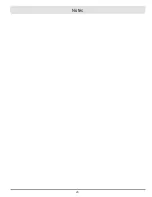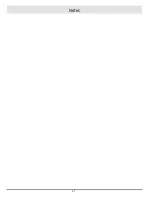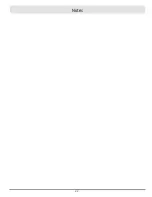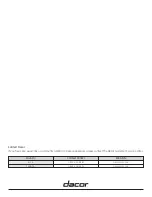
11
Operating the Range
Tips: Broiling
Broiling is a quick,
fl
avorful way to cook such foods as steak,
chicken, chops, hamburgers, and
fish. It is normal and ne
cessary
for some smoke to be present to give the food a broiled
fl
avor.
• Always set a timer when broiling.
• Use a room-temperature broiler pan for even cooking.
• Use tongs or a spatula to handle meat. (Piercing meat with a
fork lets natural juices escape.)
• Broil food slightly over half the recommended time, then season
and turn. Season the second side just before removing the food.
• To prevent sticking, lightly oil the broiler grill. For easier clean-
ing, remove the broiler pan and grill when you remove the food.
Tips: Roasting
• Optional roasting pans work very well.
• Optional V-shaped racks and broil/roast pans allow excellent
air circulation all around the food.
• If using a cooking bag, foil tent, or other cover, use Convection
Bake mode; adjust recipe time and temperature accordingly.
• If using a meat thermometer:
-
insert the probe halfway into the center of the meat’s thick-
est portion; (for poultry, insert the probe between the body
and leg into the thickest part of the inner thigh)
-
keep the probe tip away from bone, fat, and gristle
-
insert the probe ½” farther into the meat, and take another
reading. If the second reading is lower, keep cooking.
• Let roasts sit 15 – 20 minutes after roasting to ease carving.
• Roast times vary with the size, shape, and quality of the meat/
poultry. Tougher cuts are best prepared in Bake mode and may
need moist cooking techniques. Follow recipe directions.
Tips: Multi-Rack Baking
• Standard Bake mode is best for multi-rack baking.
• Pizza, cake, cookies, biscuits
, muffin
s, rolls, and frozen conve-
nience foods) can be prepared on two or three racks at once.
• Typically, rack Levels 2, 4, and 6 are best for multi-rack baking.
• When adapting a single-rack recipe to multi-rack baking, you
may need to lengthen the bake time due to the greater amount
of food in the oven.
Tips: Bakeware
• For best results, use the pan size/ty
pe specified in
the recipe.
• Bake cake, quick br
ead, muffin
s, and cookies in shiny, re
fl
ective
pans for light-golden surfaces. (Do not use old, darkened pans.)
• Bake cookies, biscuits, and cream puffs on medium-gauge
aluminum sheets with low sides.
• Bake most frozen food in the original foil package on a cookie
sheet. (Follow package directions.)
• For glass bakeware, reduce the recipe temperature by 25°F,
except for pie or yeast bread.
• Follow the standard recipe baking time for pie and yeast bread.
• Warped, dented, stainless-steel, and tin-coated pans heat
unevenly, giving inconsistent results.
About High-Altitude Cooking
At higher altitudes (3000 feet/914 meters and above), foods tend
to take longer to cook due to lower atmospheric pressure, so some
recipes need adjusting.
Usually, no adjustment is needed for yeast-risen goods, though let-
ting the dough rise twice before the
final pan-rise imp
roves
fl
avor.
Try the adjustments below; note the changes that work best for
you. Consulting a cookbook on high-altitude baking is also useful.
Reduction Amounts for Some Popular Ingredients:
Low- to High-Altitude Conversion
Altitude
(feet)
Baking powder
(for each tsp,
decrease by)
Sugar
(for each tsp,
decrease by)
Liquid
(for each cup,
add)
3000
5-10%
10-25%
5-10%
5000
10%
10%
20%
7000
25%
20%
20-25%

















